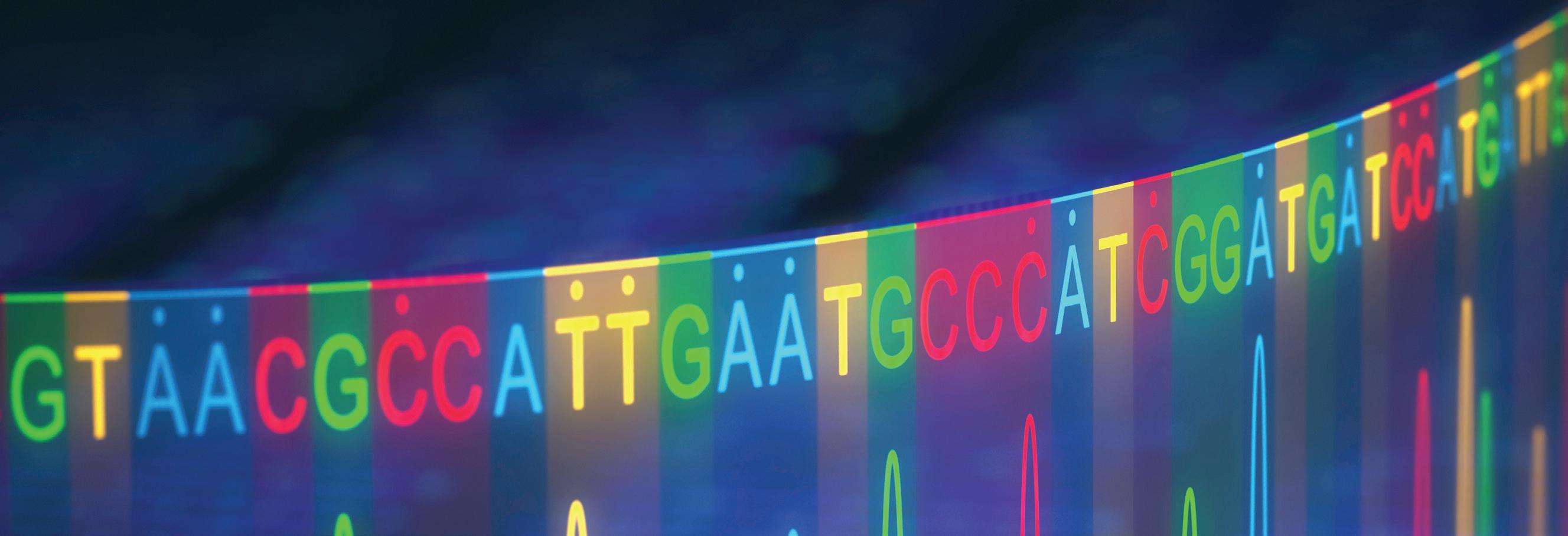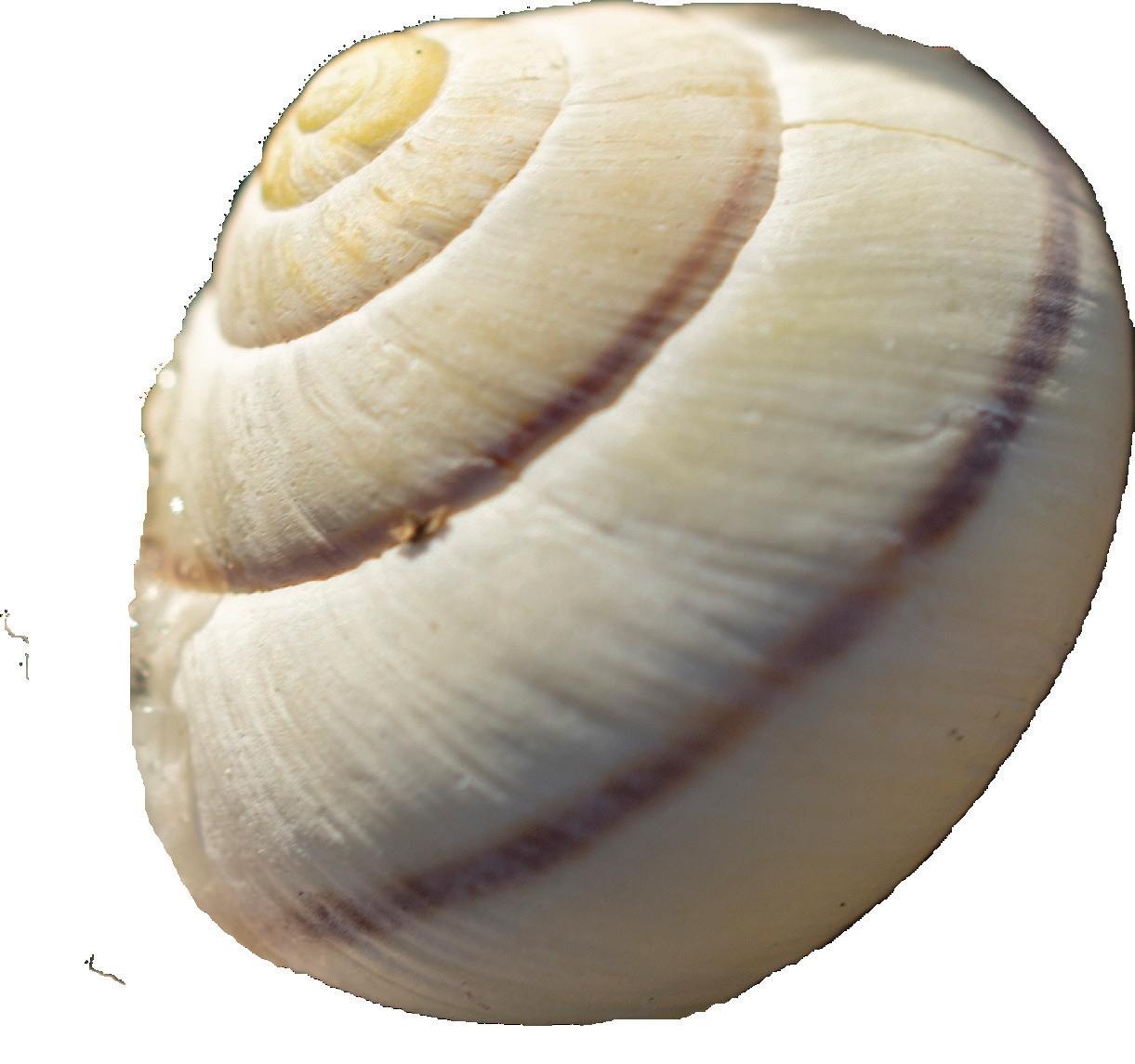
11 minute read
Hidden Markov Models for biochemical applications
FOR
BY DINA ZEMLYANKER, DATA SCIENCE & BIOCHEMISTRY, 2024 DESIGN BY KATIE GREEN, BIOENGINEERING, 2022
Advertisement
As the amount of data in the
biological field expands exponentially as a result of more
efficient biological processes, such as Next Gen Sequencing, machine learning has become a tool to leverage this data for contributions to the drug development and medicinal fields. One of the most widely utilized machine learning models is the Hidden Markov Model (HMM).
HMMs are based on Markov chains, a mathematical system that illustrates the probabilities of transitions between states. For example, in a Markov model describing weather, it could have two states: rainy and sunny. The Markov model would show the probability that given that today was rainy, tomorrow is sunny and vice versa. In HMMs, there is an added complication called observables. These are useful when directly seeing whether it is sunny or rainy is impossible, making these states “invisible.” For example, for an HMM predicting the weather, the invisible states would be rainy and sunny, and the observations could be what people outside are wearing. In simpler terms, the model could predict which days in a week will be rainy and which will be sunny based on people’s outfits.
To determine the sequence of states, researchers use the probability of seeing each observable given a certain invisible state, known as the emission probability. The collection of all of these probabilities is called the emission probability matrix, while all transition probabilities between states are called the transition probability matrix. These two matrices are combined to determine the probability of the next invisible state.
For a protein predicting HMM, the invisible states can be the exons and introns. Exons are the regions of RNA that code for proteins and introns are the non-coding regions. For every state in the model, there is a different set of emission probabilities based on the observable qualities of each exon and intron. There are multiple uses to this kind of HMM. The first way to use this would be computing whether or not the sequence is coding, which means that it contains the instructions
to create a protein. Another way would be to predict the locations of exons and introns given that it codes for a protein. For this process, the states would first be predicted using the observables. After predicting the optimal sequence of states, it will be clear which codons belong to which exon or intron based on their locations.
The optimal path or sequence of latent states is found using one of a few different possible algorithms, including the forward and Viterbi algorithm. The Viterbi algorithm is usually used when trying to determine the entire optimal state sequence rather than just the next state, and it works by
recursively finding the maximum probability of one latent state following another latent state, given the observables.
Out of the plethora of biological applications of HMMs, the most useful have proven to be modeling characteristics of protein families, such as globins and kinases, to help classify new proteins into different protein families. This allows researchers to infer qualities and find multiple sequence alignments, which are when proteins are compared by sequence and assigned a similarity score. The most popular implementation of this is the Sequence Alignment and Modeling System (SAM), which is used for multi-protein sequence alignment and profiling using HMMs. Another essential application of HMMs is in protein structure prediction, where the protein structure is determined using both an HMM and an unfamiliar protein sequence; this has proven to be very useful in drug development and medicine.
Knowing the properties and shapes of proteins, drugs can be created to ameliorate their negative effects by making changes to their structures and interrupting their processes. With the help of HMMs, scientists can develop new medicines much more cheaply and quickly.
Genomics, Proteomics & Bioinformatics (2004). DOI: 10.1016/S1672-0229(04)02014-5 Curr Genomics. (2009). DOI: 10.2174/138920209789177575
PHOTO BY SHUTTERSTOCK

The Golden Ratio:

Myth or magic of mathematics?
BY LOUISE HOLWAY, ARCHITECTURE & CIVIL ENGINEERING, 2022 DESIGN BY PARKER HITT, BIOLOGY, 2024
To most, irrational numbers seem — well — irrational. We may be familiar with pi (π), Euler’s Number (e), and the square root of two, but a lesser known irrational number may hold many secrets to the universe: the Golden Ratio. From the Pyramids of Giza to the Mona Lisa to vegetables, this number can be found nearly everywhere.
The Golden Ratio occurs when a line is divided in two, where the longer part (a) divided by the shorter part (b) equals the total length of the line (a+b) divided by the longer part (a); a is to b as a+b is to a. It is approximately 1:1.618 and is represented by the Greek letter Φ (Phi). Closely related is the Fibonacci Sequence, a series of numbers where every number is the sum of the two preceding numbers. For example: 1, 1, 2, 3, 5, 8, 13, 21 … As the values become larger, the ratio becomes more accurate by accumulating more decimals.
This ratio can be found throughout nature. For instance, the spiral in sunflowers and pinecones follows the Golden Ratio. For both, seeds grow along two intersecting spirals that move in opposite directions, and every seed belongs to both spirals. In pinecones, eight seeds move in a clockwise direction, and thirteen move counterclockwise. In sunflowers, the “ numbers are even larger (21:34) and more accurate.
The iconic spiral can also be found in hurricanes, seashells, and even the human skull. A 2019 study from John Hopkins University compared 100 human skulls. The nasioniac arc connects the tip of the nasal bone to the inion, a small bump on the back of the skull, and the bregma is a curve on the top of the skull that follows a similar path that a headband would. In all of the 100 skulls researchers studied, they found that the bisection of these points creates two arcs whose distances exhibit the Golden Ratio.
Not only is the Golden Ratio embedded in our skulls, research has shown that it is hardwired into our brains. Adrian Bejan, professor of mechanical energy at Duke University, suggests that evolution has made the human eye capable of interpreting images featuring the Golden Ratio faster than those that do not.
Bejan argues that the human world is oriented horizontally rather than vertically. This is because attacks come from our right, left, back, front, in between far more often than up or down. The scope of vision has evolved accordingly, and the eye takes in information more efficiently when it scans side-toside. Over time, this field of vision has taken the proportions of the Golden Ratio. Our brain recognizes it and associates it with beauty and harmony without us even knowing.
For this reason, artists and designers take advantage of the aesthetic qualities of the proportion. The earliest known use dates back to 450 BCE, when Greek sculptor Phidias used it in his art. Since then, it has been used in paintings like Leonardo Da Vinci’s “Mona Lisa” and Salvador Dali’s “The Sacrament of the Last Supper.” It has also been portrayed in buildings like the Parthenon in Athens, and renowned architect Le Corbusier relied on it for many of his projects.
Peter Wiederspahn, principal of Wiederspahn Architecture LLC and associate professor of architecture at Northeastern University, states that the Golden Ratio is steeped in Renaissance architecture and theory, with much of the inspiration coming from music:
“Sounds are based on intervals of chord progressions,” Wiederspahn said. ”Sound is a natural phenomenon, but we can artificially create these phenomena.”
After years of experience in the field, Widerspahn has had an innate sense of the Golden Ratio since the beginning of his architecture practice. While it is applied “conscientiously or subconsciously,” the Golden Ratio makes sense in many designs. While some call it magical, others call it practical. It is derived from nature and unintelligent systems. Our mind’s eye is attracted to natural systems — for example, “a hospital window oriented towards a forest has more benefits to the human psyche than one that faces a parking lot,” said Widersphahn.
Whether we know it or not, the Golden Ratio is all around us, and we use it unknowingly on a daily basis. It raises the questions of why this ratio is so common and how the world, galaxy, and even universe are based on a divine proportion.
Journal of Craniofacial Surgery (2019). DOI: 10.1097/SCS.0000000000005610 International Journal of Design & Nature and Ecodynamics (2009). DOI: 10.2495/DNE-V4-N2-97-104 Computers & Mathematics with Applications (2008). DOI: 10.1016
PHOTO BY WIKIPEDIA CREATIVE COMMONS

Fibonacci's Formula to Life
A blueprint for beauty and nature
BY NETHRA IYER, CHEMICAL ENGINEERING, 2024
In the hit show “Criminal Minds,” Dr. Spencer Reid is known for his high intelligence and ability to see the world in a way that normal people cannot. One of his most iconic moments is in Season 4 Episode 8, where he is able to identify the link between abducted women and their location using the Fibonacci Sequence. He explains that it is “a ratio found all through life.” This is known as the Golden Ratio, best approximated by the Fibonacci Sequence, and is created geometrically through a logarithmic spiral. It is what society sees as beautiful, as some of the most enchanting and breathtaking aspects of nature follow this seemingly simple shape and sequence from flowers to sea shells.
The Fibonacci Sequence is named after Italian mathematician Leonardo Pisano, more commonly known as Fibonacci, who explained this series in his famous book, “Liber Abaci.” He poses the question: “Quot paria coniculorum in uno anno ex uno pario germinentur?” This roughly translates to “How many pairs of rabbits will spring in one year from one pair?” This assumes some parameters — like walls surrounding the rabbits, preventing them from escaping. Fibonacci then goes on to explain that the rabbit gives birth to one pair of rabbits and again during the second month. “Quia suprascriptum par in primo mense germinat, duplicabis ipsum, erunt paria duo in uno mense.” This means that because the pair of rabbits gives birth in the first month, there will be two pairs in the second month, and so on. The pattern then continues with each new pair also giving birth. Written numerically, it comes to 0, 1, 1, 2, 3, 5, and so on. To graph these numbers, squares are drawn, with sizes corresponding to each of the aforementioned numbers, with 1 being the smallest. In each square, a curve is drawn and connected to the previous, creating a spiral that can be seen all throughout the natural world.
One of the most common areas in nature where the Fibonacci Sequence can be seen is in flowers and pine cones. In many flowers, the arrangement or number of petals are actually Fibonacci numbers. For example, a lily found in a pond will have 3 petals, a wild rose will have 5 petals, and a daisy will have 55 petals. All of these numbers are in the Fibonacci Sequence. According to the research article “The Fibonacci Sequence: Nature’s Little Secret” by Nikoletta Minarova, flowers follow this pattern because it “provides an evolutionary advantage in promoting the plant’s survival.” This means that the Fibonacci Sequence is like a code for survival for many flowers. This is due to the angle between each of the petals — the Fibonacci Sequence allows for flowers to have specific angles that are best for growth.
Flowers are not the only aspects of nature where the sequence can be seen. Many pine cones also follow the spiral created by those numbers. Each fold in the pinecone is a spiral. The first moves from top to bottom, whilst the second moves from bottom to top. Minarova gives an example of how one pine cone has a spiral that reaches the number eight, followed by a spiral that reaches the number 13 in the opposite direction, and so on. This goes to show that the simplest parts of nature, even those that can be found right outside any home, have a mathematical pattern necessary for life.
The Fibonacci spirals are also found near the sea, with seashells being some of the most studied. The most famous seashell is the nautilus shell, which has chambers that follow the shape of the logarithmic spiral. The nautilus shell is known for having the “golden proportion,” both because of its color and the fact that it is perfectly proportioned with the Golden Ratio, which is approximately 1.618. The Golden Ratio, or Phi, comes from dividing one number of Fibonacci’s sequence by the one preceding or succeeding it. Mathematicians and scientists are still unsure as to how the nautilus shell is and has been so perfectly proportioned for millions for years.
From flowers to pine cones to seashells, the Fibonacci Sequence not only makes them visually appealing but also helps in their survival, even since the age of dinosaurs. It is interesting to note that in a universe so filled with disorder, one is always trying to reach a state of entropy with some of the most curious and beautiful things being due to a simple mathematical sequence.
DESIGN AND PHOTO BY IAN PROULX, BIOENGINEERING, 2022











